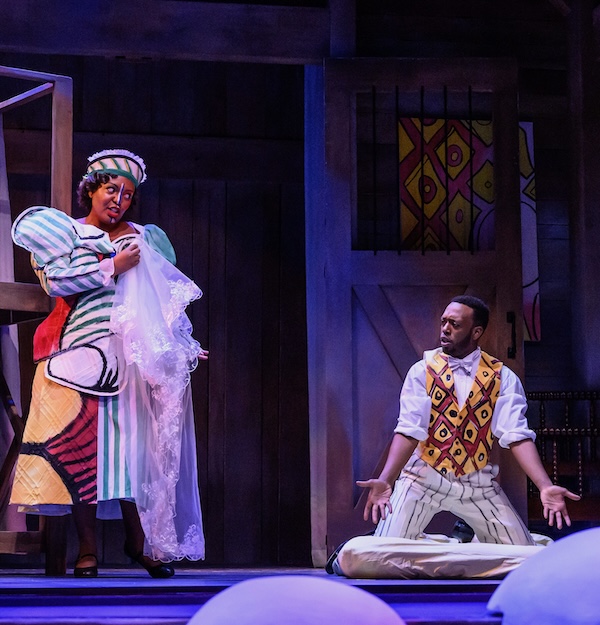Young artists provide rewards as Wolf Trap Opera opens season with Mozart’s “Figaro”

Arianna Rodriguez and Christian Simmons star in Mozart’s The Marriage of Figaro at Wolf Trap Opera. Photo: Rich Kessler/Wolf Trap
Wolf Trap Opera opened its 2025 season with a production of Mozart’s The Marriage of Figaro in the intimate Barns theater. With a cast of young artists currently making the rounds of the country’s top training programs, this Figaro was a rewarding chance to hear emerging voices building a foundation in roles they will likely revisit many times in their careers.
Arianna Rodriguez’s soprano was a fine fit for Susanna’s music, with a warm, steady core that revealed added layers of depth as the evening progressed. Her appealing stage presence ably anchored the first two acts that Susanna must tie together. Her upper register could sound pressed in more demanding ensemble passages yet Rodriguez made much of “Deh vieni, non tardar” with exquisitely spun piano effects.
Christian Simmons presented her husband-to-be Figaro as the consummate showman here, wheeling and dealing through the plot’s machinations with exuberant confidence. Simmons’ bass-baritone has a thrilling depth and resonance when fully unleashed and he used this effect liberally to enliven Figaro’s music. Of the role’s signature numbers, “Non piu Andrai” was a standout, with that big sound consistently produced throughout to satisfying effect, though a bit more pacing may have helped in other places as the singer’s hard-charging approach sometimes resulted in depleted coordination and focus.
Charles H. Eaton’s flexible baritone is not the most imposing instrument, but he wielded it here with an intent and conviction that easily dominated the stage. His Count Almaviva was among the most fully realized assumptions of the evening, skillfully straddling the tricky balance between omnipresent threat and put-upon buffoon to deliver the stakes necessary to make the farce material work. That clarity shone through in a particularly stirring “Hai già vinta la causa.”
Figaro’s world-weary Countess is perhaps the most challenging role in the show for young performers to successfully inhabit, and Brittany Olivia Logan seemed to be feeling her way into the part. “Porgi, amor,” offered glimpses of the brilliant upper extension Logan was to deploy throughout the evening, but was a bit cautious with basic dynamic effects and a tentative middle register. She settled more comfortably into the extended farce of Act II however, partnering with the Count and Susanna for an involving run through what can be a long stretch before intermission. The highlight of her evening was surely a remarkable “Dove sono,” however, a superb piece of vocal acting that demonstrated the full range of Logan’s brilliant soprano and indicated layers of emotion in the character.
Sophia Maekawa’s Cherubino frequently managed to steal the proceedings with a detailed performance that produced many of the evening’s truest comedic moments. She brought that sense of character to her vocal performance as well, parlaying a fine mezzo into winning takes on “Non so più” and “Voi che sapete.”
Among the supporting cast, Sam Dhobhany impressed with a cavernous bass in Doctor Bartolo’s music, while Elissa Pfaender, who will sing Carmen in the main Wolf Trap theater later this summer, delivered a big stage presence and strong mezzo as Marcellina. Timothy Anderson provided nicely drawn comic support as Don Basilio while Catherine Creed delivered a bright soprano and sunny presence as Barbarina.
Conductor Emily Senturia led the small orchestra in a rendition that retained an impressive degree of fluidity and precision for small-band Mozart, some occasional spreading in the strings kept to a minimum. Coordination with the singers is a challenge in this space and was a bit shaggy on opening night. While some ensembles, like Act III’s parentage reveal were dispatched with a sure hand and careful phrasing, others, like the great Act II finale, had trouble locking in and suffered from overly blunt dynamics. Choral passages were well sensitively dispatched by the extended cast featuring the company’s Studio artists.
The production, directed by E. Loren Meeker, posits the Count as a megalomaniacal artist figure on the model of Pablo Picasso, and the women of the opera as artistic objects that regain their humanity as the Count’s authority is degraded over the course of the play. In practice, that ambitious concept seemed perhaps more a driver of colorful design choices and costuming strategy than the dramatic action of the play, which fell back along largely conventional lines. While the stage business for a few solo arias, like Figaro’s “Se vuol ballare,” got a bit too elaborate, all of the farce material was clearly staged and Meeker made creative use of the space to create a sense of momentum and excitement.
Sets and costumes by Laura Fine Hawkes and Loren Shaw, respectively, executed on the Picasso theme with an exuberant color scheme and hand painted elements that provided plenty of visual interest under Colin K. Billis’ dynamic lighting.
The Marriage of Figaro runs through June 28 at Wolf Trap. wolftrap.org

